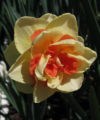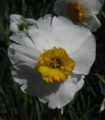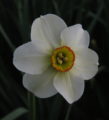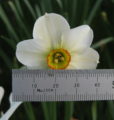Not many 11b’s have been registered this century. To my eye, judging from the photos in Daffseek, the most attractive of these is Brian Duncan’s ‘Jodi’.
Until convinced otherwise, I think a good 11b is not just split, it features the split. I understand that Harold Cross’s ‘Debate’ was so named because it was debate-ably 11b. The split is not a notable feature of the flower so I agree with the registration as 2Y-R. In my view, radial streaking color coded with a / can be an important contributor to 11b form.
So if the damage from gale force winds and hail can be excused, here are my latest additions to this relatively neglected form: –
Many more 4Y-P’s have been registered than 11b’s. My latest late 4Y-P’s are interesting to me.
16_229 4Y-P is a large very full double but has a stiff short stem that was able to hold it up in the weather. It has been a very mild wet season so whether it will do as well under normal conditions here remains to be seen.
16_224 is a red pink and hence technically 4Y-R. It’s breeding leans heavily toward 4P-P (Fragrant Rose x Music) x (Baldock x Cockatoo Dreaming). There don’t appear to many doubles of this type available yet.
Perhaps a flower can be too over-lapping. It would have been nice to see this one before the storm hit. Unfortunately it is too late to ever appear in a show here.
Lots of poets are flowering with some still to come. It was pleasing to see a miniature from last year repeat the performance. I would cheerfully show it but it will need to be checked to see if it grows beyond miniature as it matures.









Very impressive Lawrence..
Very interesting Lawrence – and I had always thought of you as a miniature and Bulbocodium breeder. We do need some good 11b’s – but it’s not easy yet. You have added to the pool of possible parents.
Hi Lawrence!
I have to admit that I never understood the reason for segregating 11a and 11b until I saw your photo above. Just the little twist of having the coronal segments between the petals seemed like a stretch of having of having to segregate (and wrecking the spacing on my daffodil data spreadsheets!). But if that radial coloring goes part and parcel for the 11b like that photo, then that is indeed a different style of flower. I had previously been of the school that if they wanted to segregate a division, then tazetta would make more sense with the doubles such as Erlicheer separated out to 8b (tho I have never counted how many double tazettas there are, so maybe it isn’t such a great idea, any way.)
I was once told that Y-Ps would always be pale because the strong pink doesn’t rest well with the paler lemony yellow, but I think you have proved that person (Dave Karnstadt, talking about all Y-Ps, not just doubles) wrong. I wonder which you prefer? The fluffy style full of petaloids, or the more tailored style?
Of course the real reason I am posting is because of the little poet. :) There is so much green in it!, but I’m guessing that the pic was taken when it was super-fresh, and after a day or two, it turned totally white in the perianth and the yellow-green in the corona turned to yellow, am I right? It doesn’t matter, the form is sweet and symmetrical and it is sooo small! Congratulations! Are there more? <g>
Suzy
Hi Suzy,
If you do a search on Daffseek for raiser J.W.A. Lefeber, division 11 you will get a good idea of what 11b should look like.
The coloring and splitting can be quite inconsistent which explains at least some of the variation in the photos. Lemon Beauty is a classic 11b. The seedparent of 16_242 is an 11b (Lemon Beauty x Twotees). Its pollen parent is also 11b but I don’t believe my pedigree. My best guess is Orange Walk x Azon.
Apparently I never attempted to breed with Debate as an 11b. It is not easy to diagnose but the lobes of Azon sit not with the petals as in 11a but are centred over the point where the petals divide at the tube as in 11b.
The Harold Cross connection is interesting. He gave such a convincing talk many years ago on the catastrophic results of crossing 11a’s with one another, that I have seldom if ever done such a cross. Unlike 11a’s there are hints here that 11b’s benefit from being intercrossed.
16_225 may derive its 11b from Azon and have no Dutch connection at all.
The classification system is based on the appearance of a flower and not its breeding hence Div.4 includes doubles regardless of their breeding. In Canberra the show schedule has different classes for single and multi-headed doubles. I think if you advocated for division 8 doubles you would advocate for div.7 doubles (see David Adam’s comment in the post on Ngaire Rogers), perhaps 6, 5, 9, 10 and even 1-3. This sort of approach could see div.4 abolished altogether. And of course, there are always boundary issues – 13_37TX is usually single headed but it has tazetta breeding – Taztep x Fortescue.
I think strong yellow with strong pink is fairly well established. Whether the colors are always pleasant is another matter. My strongest colored flower is probably the intermediate 10_307.
My favorite double is Fortescue. I think all sorts of interesting and attractive patterns are possible in doubles. The dappled D-shaped blob is not the best kind of double in my view. So of the 2 above I prefer 16_224. I imagine judges struggle with the issue.
Interestingly a 2P-P sibling of the 2Y-R double 16_224 has now flowered. It shows in a surprising way how the overlap in petals can help reveal the color.
The mini poet has stayed miniature and retained its form, which is VERY good, but the color has burnt out completely, which is bad. Its parents are small and it has small siblings but this one is the most convincing miniature in plant habit and flower size.